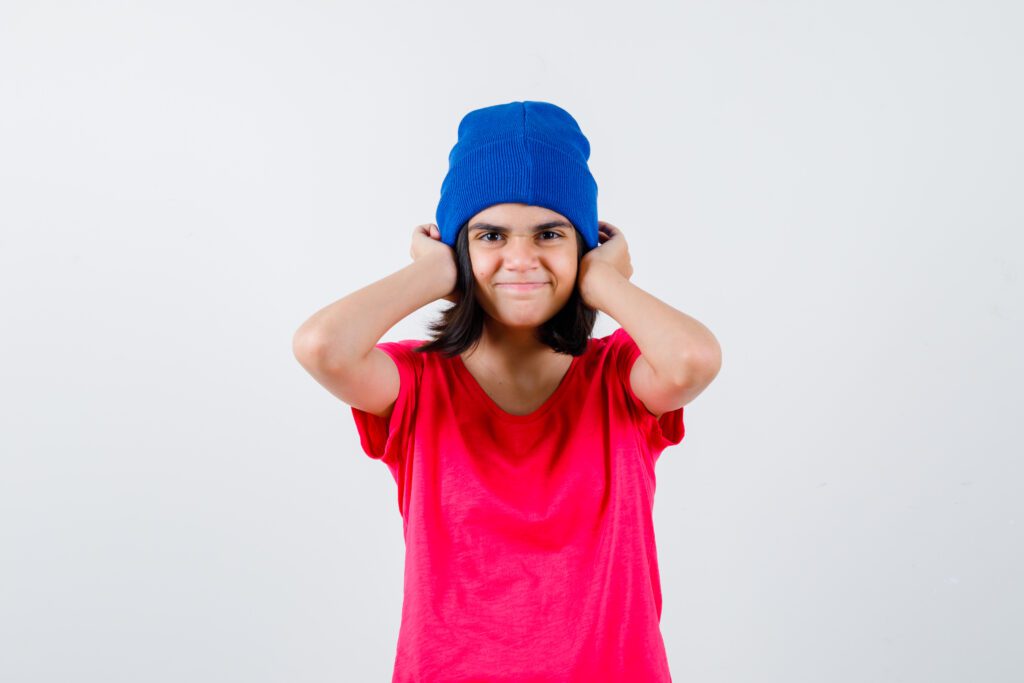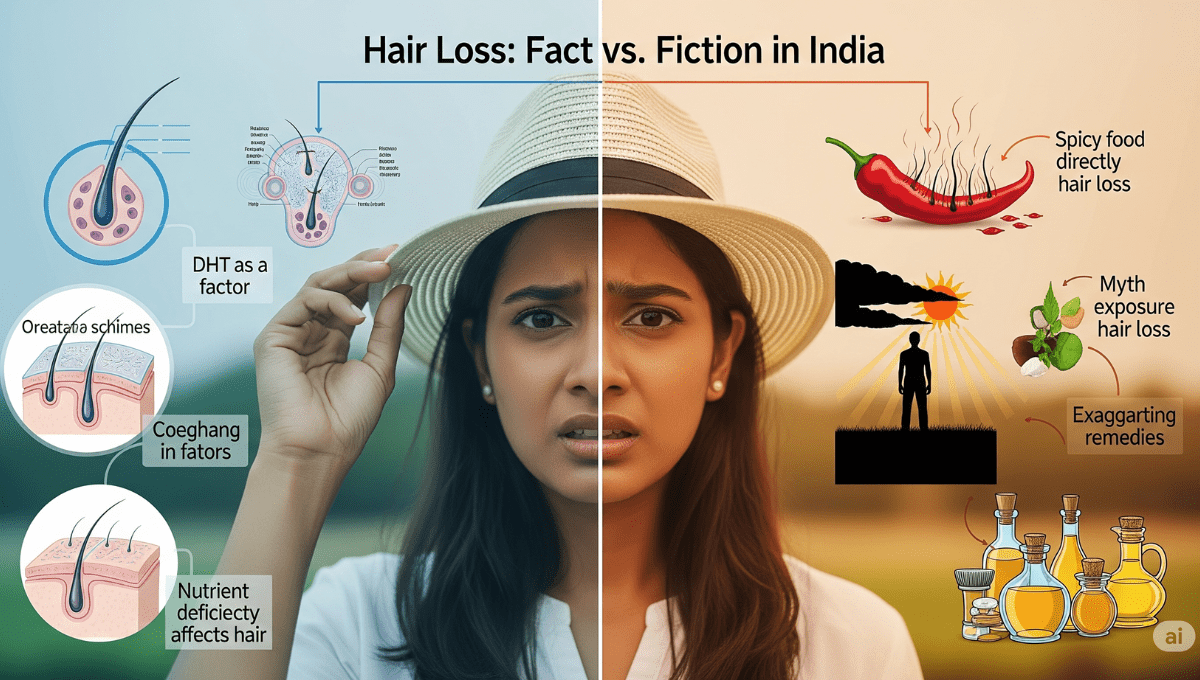Have you ever noticed your friends avoiding hats during Mumbai’s scorching summers or Delhi’s blazing afternoons, fearing they might accelerate hair loss? This age-old concern has been passed down through generations of Indian families, with many believing that regular hat usage inevitably leads to baldness. But does wearing a hat cause hair loss, or is this simply another hair-related myth that needs debunking?

In a country where temperatures soar beyond 45°C in many regions, protecting our scalp from harsh UV rays becomes crucial. Yet, the fear of hair loss often stops people from wearing protective headgear. This comprehensive guide will explore the scientific truth behind hat-wearing and hair loss, helping you make informed decisions about your hair health in the Indian context.
The Science Behind Hair Loss: Understanding the Real Culprits
Before examining whether hats cause hair loss, it’s essential to understand what actually triggers hair fall. The primary cause of hair loss in India, affecting over 60% of men and 40% women, is androgenetic alopecia or male/female pattern baldness. This genetic condition is influenced by hormones, particularly dihydrotestosterone (DHT), and has nothing to do with external accessories.
Hair follicles have a natural growth cycle consisting of anagen (growth), catagen (transition), and telogen (resting) phases. When this cycle is disrupted by genetics, hormonal changes, nutritional deficiencies, or medical conditions, hair loss occurs. External factors like pollution, stress, and improper hair care routines prevalent in Indian cities can accelerate this process, but wearing a hat is rarely the culprit.
The confusion about hats and hair loss often stems from observing hair in the hat after removal. This is perfectly normal shedding – we naturally lose 50-100 hairs daily. When you wear a hat, these shed hairs get caught in the fabric instead of falling to the ground, creating an illusion of hat-induced hair loss.
Debunking the Hat-Hair Loss Myth: What Research Really Says
Multiple dermatological studies have consistently shown that does wearing a hat cause hair loss is largely a myth. Regular hat-wearing, when done correctly, does not damage hair follicles or interfere with natural hair growth patterns. The scalp receives adequate oxygen through blood circulation, not through direct air exposure, making the “suffocation” theory unfounded.
However, there are specific circumstances where headwear might contribute to hair problems. Traction alopecia can occur when hats are worn extremely tightly for extended periods, creating constant tension on hair follicles. This condition is more commonly associated with tight hairstyles like braids or ponytails, but excessively tight caps or religious headwear can occasionally contribute to this issue.
Indian dermatologists frequently encounter patients who attribute their hair loss to hat-wearing, particularly among motorcyclists who wear helmets daily. While helmet-related hair loss concerns have some validity due to friction and tight strapping, regular hats pose minimal risk when worn appropriately.
Indian Climate Considerations: When Hats Actually Protect Hair
India’s diverse climate zones present unique challenges for hair health. In tropical regions like Kerala and coastal Karnataka, high humidity combined with heat can create scalp conditions conducive to fungal infections. In such environments, breathable hats can actually protect the scalp from excessive moisture and harmful UV radiation.
During North Indian summers, when temperatures exceed 40°C, direct sun exposure can damage hair proteins and fade natural pigments. UV radiation breaks down keratin structures, making hair brittle and prone to breakage. Quality hats with UV protection can prevent this damage, actually supporting healthier hair growth.
The monsoon season brings its own set of challenges. Wet hair combined with pollution can create ideal conditions for scalp infections. Water-resistant caps can protect against rain-related hair damage while preventing the scalp from becoming a breeding ground for bacteria and fungi.
In mountainous regions like Himachal Pradesh or Uttarakhand, cold and dry conditions can make hair brittle. Insulated caps protect against harsh winds and prevent moisture loss from hair strands, maintaining healthier hair texture throughout winter months.
Common Hat-Related Hair Concerns and Solutions
While hats don’t directly cause permanent hair loss, they can create temporary issues if not used properly. Poor hygiene is the most common problem – wearing unwashed hats can lead to scalp infections, folliculitis, or contact dermatitis. These conditions can temporarily affect hair growth but rarely cause permanent damage.
Sweat accumulation under hats, particularly common in Indian heat, can create an environment where bacteria thrive. This might lead to scalp irritation or acne-like bumps around the hairline. Regular washing of both hair and hats prevents these issues.
Material selection plays a crucial role in hat-related hair health. Synthetic materials that don’t breathe well can trap heat and moisture, while natural fibres like cotton or bamboo allow better air circulation. Indian consumers should prioritise breathable materials, especially during summer months.
Improper fit causes most hat-related hair problems. Extremely tight hats can create pressure points and restrict blood flow to certain areas of the scalp. Conversely, loose hats that slide around can cause friction and tangling, particularly for people with longer hair.
To maintain healthy hair while wearing hats regularly, choose properly fitted headwear made from breathable materials. Rotate between different hats to prevent pressure on the same scalp areas. Most importantly, maintain good scalp hygiene by washing hair regularly and keeping hats clean.
Also Read:- does whey protein cause hair loss
Professional Hair Loss Treatment: When to Seek Expert Help
If you’re experiencing significant hair loss that you suspect might be related to hat-wearing or any other cause, it’s important to consult with hair restoration specialists. Alloroots, a leading hair restoration clinic in Bhubaneswar, offers cutting-edge hair transplant solutions tailored to meet individual needs, with expert surgeons combining advanced techniques with personalised care.
Beyond hair transplants, Alloroots offers an extensive suite of services, including hair fall treatment, scalp micropigmentation, beard and eyebrow restoration, regenerative hair treatments, PRP and GFC. These advanced treatments address the root causes of hair loss rather than superficial concerns about hat-wearing.
Professional diagnosis can distinguish between temporary hair fall due to lifestyle factors and permanent hair loss requiring medical intervention. Modern treatments like Platelet Rich Plasma (PRP) therapy and Growth Factor Concentrate (GFC) can stimulate natural hair growth and strengthen existing follicles.
For individuals whose hair loss is genuinely related to traction alopecia from tight headwear, early intervention is crucial. Specialised treatments can restore damaged follicles and prevent further loss, but success depends on timely diagnosis and appropriate treatment selection.
Prevention Strategies for Healthy Hair While Wearing Hats
Maintaining optimal hair health while regularly wearing hats requires a proactive approach. Choose hats with adequate ventilation look for designs with mesh panels or breathable crown constructions. This is particularly important for Indian consumers who need head protection during extended outdoor activities.
Establish a rotation system for your headwear collection. This prevents excessive pressure on specific scalp areas and allows time for any minor irritation to heal. Professional athletes and outdoor workers often follow this practice to maintain scalp health.
Pay attention to material quality and construction. Smooth inner linings reduce friction against hair strands, while moisture-wicking fabrics help manage sweat accumulation. Invest in quality headwear rather than cheap alternatives that might cause more harm than good.
Timing matters significantly. Avoid wearing hats immediately after washing hair, as damp conditions can promote bacterial growth. Similarly, remove hats periodically during the day to allow air circulation, especially during intense physical activities.
Scalp massage while wearing hats can improve blood circulation and prevent any potential restriction of nutrient flow to hair follicles. Simple techniques like gentle circular motions can be performed even with lightweight caps in place.
Also Read:- How long does a hair transplant last
The Verdict: Making Informed Decisions About Hat Usage
The scientific consensus is clear: does wearing a hat cause hair loss is primarily a myth perpetuated by misunderstanding natural hair shedding patterns. Regular, appropriate hat usage does not damage hair follicles or interfere with healthy hair growth cycles.
For Indian consumers, the benefits of hat-wearing often outweigh the minimal risks. Protection from UV radiation, pollution, and extreme weather conditions supports overall hair health more than the negligible risk of hat-related problems.
However, this doesn’t mean all headwear practices are harmless. Extremely tight hats worn for extended periods can contribute to traction alopecia, and poor hygiene can lead to scalp infections. The key lies in choosing appropriate headwear, maintaining good hygiene, and using common sense about fit and duration.
If you’re experiencing hair loss, don’t blame your hat collection. Instead, consider genetic factors, nutritional status, stress levels, and overall health. Professional consultation can identify the real causes and provide effective treatment options.
Remember that protecting your scalp from harsh environmental conditions often does more good than harm. Quality hats serve as shields against sun damage, pollution, and extreme temperatures all factors that can negatively impact hair health when left unchecked.
By making informed choices about headwear and maintaining proper scalp hygiene, you can enjoy the benefits of hat-wearing without compromising your hair health. Focus on addressing real hair loss causes rather than avoiding protective accessories based on unfounded fears.
Frequently Asked Questions
Q: Can wearing a cap daily cause baldness in young adults?
Daily cap wearing does not cause baldness in young adults. Genetic factors and hormonal changes are the primary causes of baldness, not external accessories like caps or hats.
Q: Does sweating under a hat damage hair follicles permanently?
Sweating under hats does not permanently damage hair follicles. However, poor hygiene and accumulated sweat can cause temporary scalp irritation that should be addressed through regular washing.
Q: Are there specific hat materials that are safer for hair health?
Natural, breathable materials like cotton, bamboo, or linen are safer for hair health. These materials allow better air circulation and moisture management compared to synthetic alternatives.
Q: How tight is too tight when it comes to hat fitting?
A hat is too tight if it leaves visible marks on your forehead, causes headaches, or creates pressure points. Proper fit should be snug but comfortable without restricting blood circulation.
Q: Should people with thinning hair avoid wearing hats completely?
People with thinning hair should not avoid hats completely. Proper sun protection can actually benefit thinning hair by preventing UV damage. Choose lightweight, breathable options and maintain good scalp hygiene.


Dr. Alok is a renowned Pan India Hair Restoration Surgeon with an MD in Dermatology & Venereology from AIIMS, New Delhi. With over 3000 successful hair transplants to his name, he has transformed the lives of thousands across the country, providing expert hair care with a focus on integrity, precision, and personalized solutions. His vast experience and commitment to excellence make him a trusted leader in the field of hair restoration.


